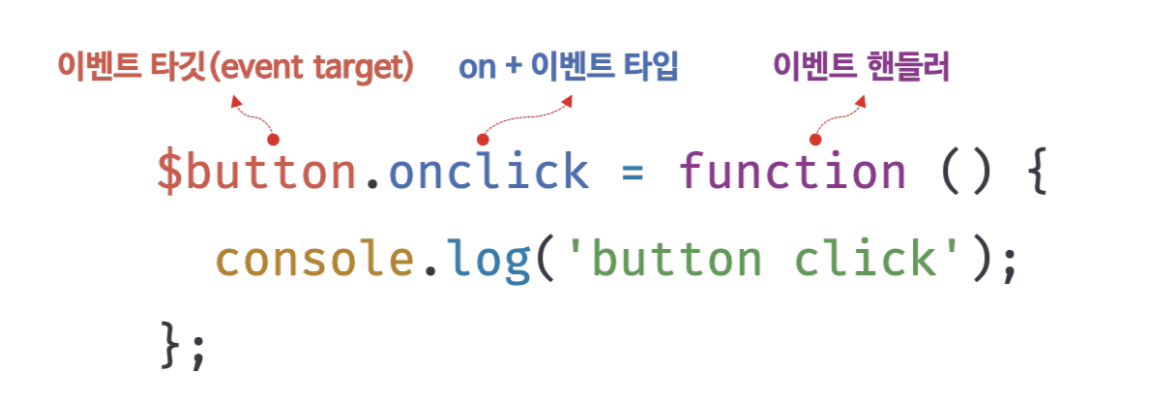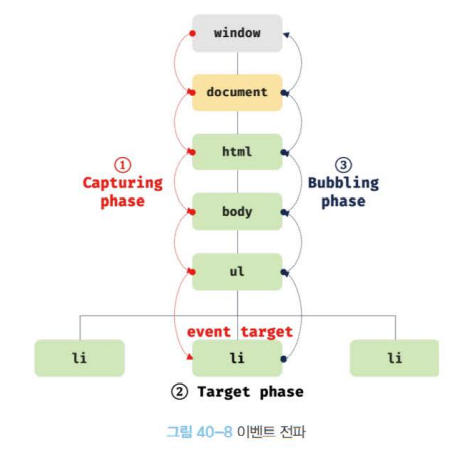이벤트
1. 이벤트 드리븐 프로그래밍
-
브라우저는 처리해야 할 특정 사건이 발생하면 이를 감지하여 이벤트를 발생시킨다. 예를 들어 클릭, 키보드 입력, 마우스 이동이 있다.
-
애플리케이션이 특정 타입의 이벤트에 대해 반응하여 어떤 일을 하고 싶다면 해당하는 타입의 이벤트가 발생했을 때 호출될 함수를 브라우저에 알려 호출을 위임한다.
이벤트 핸들러: 이벤트가 발생했을 때 호출될 함수이벤트 핸들러 등록: 이벤트가 발생했을 때 브라우저에게 이벤트 핸들러의 호출을 위임하는 것
<!DOCTYPE html>
<html>
<body>
<button>Click me!</button>
<script>
const $button = document.querySelector("button");
// 사용자가 버튼을 클릭하면 함수를 호출하도록 요청
$button.onclick = () => {
alert("button click");
};
</script>
</body>
</html>
이처럼 이벤트와 그에 대응하는 함수를 통해 사용자와 애플리케이션은 상호작용을 할 수 있다.
이와 같이 프로그램의 흐름을 이벤트 중심으로 제어하는 프로그래밍 방식을 이벤트 드리븐 프로그래밍이라 한다.
2. 이벤트 타입
-
이벤트 타입은 이벤트의 종류를 나타내는 문자열이다. 약 200여가지가 있다.
-
이벤트 타입에 대한 상세목록은 아래 링크에서 확인할 수 있다.
-
MDN Event reference
마우스 이벤트
| 이벤트 타입 | 이벤트발생시점 |
|---|---|
| click | 마우스 버튼을 클릭했을 때 |
| dbclick | 마우스 버튼을 더블 클랙했을 때 |
| mousedown | 마우스 버튼을 눌렀을 때 |
| mouseup | 누르고 있던 마우스 버튼을 놓았을 때 |
| mousemove | 마우스 커서를 움직였을 때 |
| mouseenter | 마우스 커서를 HTML요소 안으로 이동했을 때 (버블링 되지 않는다) |
| mouseover | 마우스 커서를 HTML 요소 안으로 이동했을 때 (버블링된다) |
| mouseleave | 마우스 커서를 HTML 요소 밖으로 이동했을 때 (버블링 되지 않는다) |
| mouseout | 마우스 커서를 HTML 요소 밖으로 이동했을 때 (버블링된다) |
키보드 이벤트
| 이벤트타입 | 이벤트 발생 시점 |
|---|---|
| keydown | 모든 키를 눌렀을 때 발생한다. |
| keypress | 문자 키를 눌렀을 때 연속적으로 발생한다. (문자, 숫자, 특수 문자, enter) |
| keyup | 누르고 있던 키를 놓았을 때 한 번만 발생한다. |
3. 이벤트 핸들러 등록
-
이벤트 핸들러는 이벤트가 발생하면 브라우저에 의해 호출될 함수다.
-
이벤트 핸들러를 등록하는 방법은 3가지다.
이벤트 핸들러 어트리뷰트 방식
-
이벤트 핸들러 어트리뷰트의 이름은 onclick과 같이 on 접두사와 이벤트의 종류를 나타내는 이벤트 타입으로 이루어져 있다.
- 이벤트 핸들러 어트리뷰트 값으로 함수 호출문 등의 문을 할당하면 이벤트 핸들러가 등록된다.
- 주의할 점은 이벤트 핸들러 어트리뷰트 값으로 함수 참조가 아닌, 함수 호출문 등의 문을 할당한다는 것이다.
<!DOCTYPE html>
<html>
<body>
<button onclick="sayHi('Lee')">Click me!</button>
<script>
function sayHi(name) {
console.log(`Hi! ${name}.`);
}
</script>
</body>
</html>
- CBD(Component Based Development) 방식의 Angular, React, Vue, Svelt 같은 프레임워크/ 라이브러리에서는 핸들러 어트리뷰트 방식으로 이벤트를 처리한다.
<!-- Angular -->
<button (click)="handleClick($event)">Save</button>
<!-- React -->
<button onClick="{handleClick}">Save</button>
<!-- Svelte -->
<button on:click="{handleClick}">Save</button>
<!-- Vue.html -->
<button v-on:click="handleClick($event)">Save</button>
이벤트 핸들러 프로퍼티 방식
-
window 객체와 Document, HTMLElement 타입의 DOM 노드 객체는 이벤트에 대응하는
이벤트 핸들러 프로퍼티를 가지고 있다. - 이벤트 핸들러 프로퍼티의 키는 이벤트 핸들러 어트리뷰트와 마찬가지로 onclick과 같이 on 접두사와 이벤트의 종류를 나타내는 이벤트 타입으로 이루어져 있다.
- 이벤트 핸들러 프로퍼티에 함수를 바인딩하면 이벤트 핸들러가 등록된다.
<!DOCTYPE html>
<html>
<body>
<button>Click me!</button>
<script>
const $button = document.querySelector("button");
// 이벤트 핸들러 프로퍼티에 이벤트 핸들러를 바인딩
$button.onclick = function () {
console.log("button click");
};
</script>
</body>
</html>
이벤트 핸들러를 등록하기 위해서는 이벤트를 발생시킬 객체인 이벤트 타겟 과 이벤트의 종류를 나타내는 문자열인 이벤트 타입 그리고 이벤트 핸들러를 지정할 필요가 있다.

-
이벤트 핸들러는 대부분 이벤트를 발생시킬
이벤트 타킷에 바인딩한다. - 하지만 반드시 이벤트 타킷에 이벤트 핸들러를 바인딩해야하는 것은 아니다.
- 이벤트 핸들러는 이벤트 타킷 또는 전파된 이벤트를 캐치할
DOM 노드 객체에 바인딩한다. 이벤트 핸들러 어트리뷰트 방식도 결국 DOM 노드 객체의 이벤트 객체의이벤트 핸들러 프로퍼티로 변환되므로 결과적으로 동일하다이벤트 핸들러 프로퍼티 방식은이벤트 핸들러 어트리뷰트 방식의 HTML과 자바스크립트가 뒤섞이는 문제를 해결 할 수 있다.- 하지만
이벤트 핸들러 프로퍼티에 하나의 이벤트 핸들러만 바인딩할 수 있다는 단점이 있다.
<!DOCTYPE html>
<html>
<body>
<button>Click me!</button>
<script>
const $button = document.querySelector("button");
// 이벤트 핸들러 프로퍼티 방식은 하나의 이벤트에 하나의 이벤트 핸들러만을 바인딩할 수 있다.
// 첫 번째로 바인딩된 이벤트 핸들러는 두 번째 바인딩된 이벤트 핸들러에 의해 재할당되어
// 실행되지 않는다.
$button.onclick = function () {
console.log("Button clicked 1");
};
// 두 번째로 바인딩된 이벤트 핸들러
$button.onclick = function () {
console.log("Button clicked 2");
};
</script>
</body>
</html>
addEventListner 방식
- DOM Level 2에서 도입된
EventTarget.prototype.addEventListener메서드를 사용하여 이벤트 핸들러를 등록할 수 있다.

<!DOCTYPE html>
<html>
<body>
<button>Click me!</button>
<script>
const $button = document.querySelector("button");
// 이벤트 핸들러 프로퍼티 방식
// $button.onclick = function () {
// console.log('button click');
// };
// addEventListener 메서드 방식
$button.addEventListener("click", function () {
console.log("button click");
});
</script>
</body>
</html>
- 이벤트 핸들러 프로퍼티 방식은 이벤트 핸들러 프로퍼티에 이벤트 핸들러를 바인딩하지만 addEventListener 메서드에는 이벤트 핸들러를 인수로 전달한다.
<!DOCTYPE html>
<html>
<body>
<button>Click me!</button>
<script>
const $button = document.querySelector("button");
// 이벤트 핸들러 프로퍼티 방식
$button.onclick = function () {
console.log("[이벤트 핸들러 프로퍼티 방식]button click");
};
// addEventListener 메서드 방식
$button.addEventListener("click", function () {
console.log("[addEventListener 메서드 방식]button click");
});
</script>
</body>
</html>
-
addEventListener 메서드 방식은 이벤트 핸들러 프로퍼티에 바인딩된 이벤트 핸들러에 아무런 영향을 주지 않는다. 따라서 버튼 요소에서 클릭 이벤트가 발생하면 2개의 이벤트 핸들러가 모두 호출된다.
-
동일한 HTML 요소에 addEventListener를 이용하여 하나 이상의 이벤트 핸들러를 등록할 수 있다. 이때 이벤트 핸들러는 등록된 순서대로 호출된다.
<!DOCTYPE html>
<html>
<body>
<button>Click me!</button>
<script>
const $button = document.querySelector("button");
// addEventListener 메서드는 동일한 요소에서 발생한 동일한 이벤트에 대해
// 하나 이상의 이벤트 핸들러를 등록할 수 있다.
$button.addEventListener("click", function () {
console.log("[1]button click");
});
$button.addEventListener("click", function () {
console.log("[2]button click");
});
</script>
</body>
</html>
- 단, addEventListener 메서드를 통해 참조가 동일한 이벤트 핸들러를 중복 등록하면 하나의 이벤트 핸들러만 등록된다.
<!DOCTYPE html>
<html>
<body>
<button>Click me!</button>
<script>
const $button = document.querySelector("button");
const handleClick = () => console.log("button click");
// 참조가 동일한 이벤트 핸들러를 중복 등록하면 하나의 핸들러만 등록된다.
$button.addEventListener("click", handleClick);
$button.addEventListener("click", handleClick);
</script>
</body>
</html>
4. 이벤트 핸들러 제거
-
addEventListener로 등록한 이벤트 핸들러를 제거하려면 EventTarget.prototype.removeEventListener 메서드를 사용한다.
-
단, addEvenetListener 메서드에 전달한 인수와 removeEventListener 메서드에 전달한 인수가 일치하지 않으면 이벤트 핸들러가 제거되지 않는다.
<!DOCTYPE html>
<html>
<body>
<button>Click me!</button>
<script>
const $button = document.querySelector("button");
const handleClick = () => console.log("button click");
// 이벤트 핸들러 등록
$button.addEventListener("click", handleClick);
// 이벤트 핸들러 제거
// addEventListener 메서드에 전달한 인수와 removeEventListener 메서드에
// 전달한 인수가 일치하지 않으면 이벤트 핸들러가 제거되지 않는다.
$button.removeEventListener("click", handleClick, true); // 실패
$button.removeEventListener("click", handleClick); // 성공
</script>
</body>
</html>
- 이벤트 핸들러 프로퍼티 방식으로 등록한 이벤트 핸들러는 removeEventListener로 제거할 수 없다. 이벤트 핸들러 프로퍼티 방식으로 등록한 이벤트 핸들러를 제거하려면 이벤트 핸들러 프로퍼티에 null을 할당한다.
<!DOCTYPE html>
<html>
<body>
<button>Click me!</button>
<script>
const $button = document.querySelector("button");
const handleClick = () => console.log("button click");
// 이벤트 핸들러 프로퍼티 방식으로 이벤트 핸들러 등록
$button.onclick = handleClick;
// removeEventListener 메서드로 이벤트 핸들러를 제거할 수 없다.
$button.removeEventListener("click", handleClick);
// 이벤트 핸들러 프로퍼티에 null을 할당하여 이벤트 핸들러를 제거한다.
$button.onclick = null;
</script>
</body>
</html>
5. 이벤트 객체
-
이벤트가 발생하면 이벤트에 관련한 다양한 정보를 담고 있는 이벤트 객체가 동적으로 생성된다.
-
생성된 이벤트 객체는 이벤트 핸들러의 첫 번째 인수로 전달된다.
<!DOCTYPE html>
<html>
<body>
<p>클릭하세요. 클릭한 곳의 좌표가 표시됩니다.</p>
<em class="message"></em>
<script>
const $msg = document.querySelector(".message");
// 클릭 이벤트에 의해 생성된 이벤트 객체는 이벤트 핸들러의 첫 번째 인수로 전달된다.
function showCoords(e) {
$msg.textContent = `clientX: ${e.clientX}, clientY: ${e.clientY}`;
}
document.onclick = showCoords;
</script>
</body>
</html>
- 이벤트 핸들러 어트리뷰트 방식으로 이벤트를 등록했다면 다음과 같이 event를 통해 이벤트 객체를 전달받을 수 있다.
<!DOCTYPE html>
<html>
<head>
<style>
html,
body {
height: 100%;
}
</style>
</head>
<!-- 이벤트 핸들러 어트리뷰트 방식의 경우 event가 아닌 다른 이름으로는 이벤트 객체를
전달받지 못한다. -->
<body onclick="showCoords(event)">
<p>클릭하세요. 클릭한 곳의 좌표가 표시됩니다.</p>
<em class="message"></em>
<script>
const $msg = document.querySelector(".message");
// 클릭 이벤트에 의해 생성된 이벤트 객체는 이벤트 핸들러의 첫 번째 인수로 전달된다.
function showCoords(e) {
$msg.textContent = `clientX: ${e.clientX}, clientY: ${e.clientY}`;
}
</script>
</body>
</html>
이벤트 객체 상속 구조
-
이벤트가 발생하면 이벤트 사앹에 따라 다양한 타입의 이벤트 객체가 생성된다.
-
Event, UIEvent, MouseEvent 등은 모두 생성자 함수다. 따라서 다음과 같이 생성자 함수를 호출하여 이벤트 객체를 생성할 수 있다.
<!DOCTYPE html>
<html>
<body>
<script>
// Event 생성자 함수를 호출하여 foo 이벤트 타입의 Event 객체를 생성한다.
let e = new Event("foo");
console.log(e);
// Event {isTrusted: false, type: "foo", target: null, ...}
console.log(e.type); // "foo"
console.log(e instanceof Event); // true
console.log(e instanceof Object); // true
// FocusEvent 생성자 함수를 호출하여 focus 이벤트 타입의 FocusEvent 객체를 생성한다.
e = new FocusEvent("focus");
console.log(e);
// FocusEvent {isTrusted: false, relatedTarget: null, view: null, ...}
// MouseEvent 생성자 함수를 호출하여 click 이벤트 타입의 MouseEvent 객체를 생성한다.
e = new MouseEvent("click");
console.log(e);
// MouseEvent {isTrusted: false, screenX: 0, screenY: 0, clientX: 0, ... }
// KeyboardEvent 생성자 함수를 호출하여 keyup 이벤트 타입의 KeyboardEvent 객체를
// 생성한다.
e = new KeyboardEvent("keyup");
console.log(e);
// KeyboardEvent {isTrusted: false, key: "", code: "", ctrlKey: false, ...}
// InputEvent 생성자 함수를 호출하여 change 이벤트 타입의 InputEvent 객체를 생성한다.
e = new InputEvent("change");
console.log(e);
// InputEvent {isTrusted: false, data: null, inputType: "", ...}
</script>
</body>
</html>
-
이처럼 이벤트가 발생하면 암묵적으로 생성되는 이벤트 객체도 생성자 함수에 의해 생성된다.
-
그리고 생성된 이벤트 객체는 생성자 함수와 더불어 생성되는 프로토타입으로 구성된 프로토타입 체인의 일원이 된다.
이벤트 객체의 공통 프로퍼티
- Event 인터페이스의 이벤트 관련 프로퍼티는 모든 이벤트 객체가 상속받는 공통 프로퍼티다. 이벤트 객체의 공통 프로퍼티는 다음과 같다.
| 공통 프로퍼티 | 설명 | 타입 |
|---|---|---|
| type | 이벤트 타입 | string |
| target | 이벤트를 발생시킨 DOM요소 | DOM 요소 노드 |
| currentTarget | 이벤트 핸들러가 바인딩된 DOM요소 | DOM 요소 노드 |
| eventPhase | 이벤트 전파 단계 | number |
| bubbles | 이벤트를 버블링으로 전파하는지 여부 | boolean |
| cancelable | preventDefault 메서드를 호출하여 이벤트의 기본 동작을 취소할 수 있는지 여부 | boolean |
| defaultPrevented | preventDefault를 호출하여 이벤트를 취소했는지 여부 | boolean |
| isTrusted | 사용자의 행위에 의해 발생한 이벤트인지 여부 | boolean |
| timeStamp | 이벤트가 발생한 시각(1970/01/01/00:00:0부터 경과한 밀리초(ms)) | number |
마우스 정보 취득
-
click, dblclick, mousedown, mouseup, mousemove, mouseenter, mouseleave 이벤트가 발생하면 생성되는 MouseEvent 타입의 이벤트 객체는 다음과 같은 고유의 프로퍼티를 갖는다.
-
마우스 포인터의 좌표를 나타내는 프로퍼티 : screenX/screenY, clientX/clientY, pageX/pageY, offsetX/offsetY
-
버튼 정보를 나타내는 프로퍼티 : alKey, ctrlKey, shiftKey, button
-
키보드 정보 취득
- keydown, keyup, keypress 이벤트가 발생하면 생성되는 KeyboardEvent 타입의 이벤트 객체는 altKey, ctrlKey, shiftKey, metaKey, key, keyCode 같은 고유의 프로퍼티를 갖는다.
6. 이벤트 전파
DOM 트리 상에 존재하는 DOM 요소 노드에서 발생한 이벤트는 DOM 트리를 통해 전파된다. 이를 이벤트 전파라고 한다.
<!DOCTYPE html>
<html>
<body>
<ul id="fruits">
<li id="apple">Apple</li>
<li id="banana">Banana</li>
<li id="orange">Orange</li>
</ul>
</body>
</html>
ul 요소의 두 번째 자식 요소인 li 요소를 클릭하면 이벤트가 발생한다. 이때 생성된 이벤트 객체는 이벤트를 발생시킨 DOM 요소 이벤트 타깃을 중심으로 DOM 트리를 통해 전파된다.
이벤트 전파는 이벤트가 전파되는 방향에 따라 3단계로 구분할 수 있다.

- 캡처링 단계: 이벤트가 상위 요소에서 하위 요소 방향으로 전파
- 타겟 단계: 이벤트가 이벤트 타겟에 도달
- 버블링 단계: 이벤트가 하위 요소에서 상위 요소로 전파
<!DOCTYPE html>
<html>
<body>
<ul id="fruits">
<li id="apple">Apple</li>
<li id="banana">Banana</li>
<li id="orange">Orange</li>
</ul>
<script>
const $fruits = document.getElementById("fruits");
const $banana = document.getElementById("banana");
// #fruits 요소의 하위 요소인 li 요소를 클릭한 경우
// 캡처링 단계의 이벤트를 캐치한다.
$fruits.addEventListener(
"click",
(e) => {
console.log(`이벤트 단계: ${e.eventPhase}`); // 1: 캡처링 단계
console.log(`이벤트 타깃: ${e.target}`); // [object HTMLLIElement]
console.log(`커런트 타깃: ${e.currentTarget}`); // [object HTMLUListElement]
},
true
);
// 타깃 단계의 이벤트를 캐치한다.
$banana.addEventListener("click", (e) => {
console.log(`이벤트 단계: ${e.eventPhase}`); // 2: 타깃 단계
console.log(`이벤트 타깃: ${e.target}`); // [object HTMLLIElement]
console.log(`커런트 타깃: ${e.currentTarget}`); // [object HTMLLIElement]
});
// 버블링 단계의 이벤트를 캐치한다.
$fruits.addEventListener("click", (e) => {
console.log(`이벤트 단계: ${e.eventPhase}`); // 3: 버블링 단계
console.log(`이벤트 타깃: ${e.target}`); // [object HTMLLIElement]
console.log(`커런트 타깃: ${e.currentTarget}`); // [object HTMLUListElement]
});
</script>
</body>
</html>
캡처링 단계의 이벤트를 캐치하려면 addEventListener 메서드의 3번째 인수로 true를 전달해야 한다. 3번째 인수를 생략하거나 false를 전달하면 타깃 단계와 버블링 단계의 이벤트만 캐치할 수 있다.
이벤트 핸들러가 캡처링 단계의 이벤트를 캐치하도록 설정되어 있다면 이벤트 핸들러는 window에서 시작해서 이벤트 타깃 방향으로 전파되는 이벤트 객체를 캐치하고, 이벤트를 발생시킨 이벤트 타깃과 이벤트 핸들러가 바인딩된 커런트 타깃이 같은 DOM 요소라면 이벤트 핸들러는 타깃 단계의 이벤트 객체를 캐치한다.
이처럼 이벤트는 이벤트를 발생시킨 이벤트 타깃은 물론 상위 DOM 요소에서도 캐치할 수 있다. 즉, DOM 트리를 통해 전파되는 이벤트는 이벤트 패스에 위치한 모든 DOM 요소에서 캐치할 수 있다.
7. 이벤트 위임
<!DOCTYPE html>
<html>
<head>
<style>
#fruits {
display: flex;
list-style-type: none;
padding: 0;
}
#fruits li {
width: 100px;
cursor: pointer;
}
#fruits .active {
color: red;
text-decoration: underline;
}
</style>
</head>
<body>
<nav>
<ul id="fruits">
<li id="apple" class="active">Apple</li>
<li id="banana">Banana</li>
<li id="orange">Orange</li>
</ul>
</nav>
<div>선택된 내비게이션 아이템: <em class="msg">apple</em></div>
<script>
const $fruits = document.getElementById("fruits");
const $msg = document.querySelector(".msg");
// 사용자 클릭에 의해 선택된 내비게이션 아이템(li 요소)에 active 클래스를 추가하고
// 그 외의 모든 내비게이션 아이템의 active 클래스를 제거한다.
function activate({ target }) {
[...$fruits.children].forEach(($fruit) => {
$fruit.classList.toggle("active", $fruit === target);
$msg.textContent = target.id;
});
}
// 모든 내비게이션 아이템(li 요소)에 이벤트 핸들러를 등록한다.
document.getElementById("apple").onclick = activate;
document.getElementById("banana").onclick = activate;
document.getElementById("orange").onclick = activate;
</script>
</body>
</html>
위 예제를 살펴보면 모든 내비게이션 아이템(li)이 클릭 이벤트에 반응하도록 모든 아이템에 이벤트 핸들러를 등록했다. 이 경우 많은 DOM 요소에 이벤트 핸들러를 등록하므로 성능 저하의 원인이 되며, 유지보수에도 부적합하다.
-
이벤트 위임을 사용해 다음과 같이 코드를 수정할 수 있다.
-
이벤트 위임을 통해 하위 DOM 요소에서 발생한 이벤트를 처리할 때 주의할 점은 상위 요소에 이벤트 핸들러를 등록하기 때문에 이벤트 타깃, 즉 이벤트를 실제로 발생시킨 DOM 요소가 개발자가 기대한 DOM 요소가 아닐 수도 있다는 것이다.
-
따라서 이벤트에 반응이 필요한 DOM 요소에 한정하여 이벤트 핸들러가 실행되도록 이벤트 타깃을 검사할 필요가 있다.
<!DOCTYPE html>
<html>
<head>
<style>
#fruits {
display: flex;
list-style-type: none;
padding: 0;
}
#fruits li {
width: 100px;
cursor: pointer;
}
#fruits .active {
color: red;
text-decoration: underline;
}
</style>
</head>
<body>
<nav>
<ul id="fruits">
<li id="apple" class="active">Apple</li>
<li id="banana">Banana</li>
<li id="orange">Orange</li>
</ul>
</nav>
<div>선택된 내비게이션 아이템: <em class="msg">apple</em></div>
<script>
const $fruits = document.getElementById("fruits");
const $msg = document.querySelector(".msg");
// 사용자 클릭에 의해 선택된 내비게이션 아이템(li 요소)에 active 클래스를 추가하고
// 그 외의 모든 내비게이션 아이템의 active 클래스를 제거한다.
function activate({ target }) {
// 이벤트를 발생시킨 요소(target)가 ul#fruits의 자식 요소가 아니라면 무시한다.
if (!target.matches("#fruits > li")) return;
[...$fruits.children].forEach(($fruit) => {
$fruit.classList.toggle("active", $fruit === target);
$msg.textContent = target.id;
});
}
// 이벤트 위임: 상위 요소(ul#fruits)는 하위 요소의 이벤트를 캐치할 수 있다.
$fruits.onclick = activate;
</script>
</body>
</html>
8. DOM 요소의 기본 동작 조작
DOM 요소의 기본 동작 중단
- DOM 요소는 저마다 기본 동작이 있다.
- 이벤트 객체의
preventDefault메서드는 이러한 DOM 요소의 기본 동작을 중단시킨다.
<!DOCTYPE html>
<html>
<body>
<a href="https://www.google.com">go</a>
<input type="checkbox" />
<script>
document.querySelector("a").onclick = (e) => {
// a 요소의 기본 동작을 중단한다.
e.preventDefault();
};
document.querySelector("input[type=checkbox]").onclick = (e) => {
// checkbox 요소의 기본 동작을 중단한다.
e.preventDefault();
};
</script>
</body>
</html>
이벤트 전파 방지
- 이벤트 객체의 stopPropagation 메서드는 이벤트 전파를 중지시킨다.
<!DOCTYPE html>
<html>
<body>
<div class="container">
<button class="btn1">Button 1</button>
<button class="btn2">Button 2</button>
<button class="btn3">Button 3</button>
</div>
<script>
// 이벤트 위임. 클릭된 하위 버튼 요소의 color를 변경한다.
document.querySelector(".container").onclick = ({ target }) => {
if (!target.matches(".container > button")) return;
target.style.color = "red";
};
// .btn2 요소는 이벤트를 전파하지 않으므로 상위 요소에서 이벤트를 캐치할 수 없다.
document.querySelector(".btn2").onclick = (e) => {
e.stopPropagation(); // 이벤트 전파 중단
e.target.style.color = "blue";
};
</script>
</body>
</html>
9. 이벤트 핸들러 내부의 this
이벤트 핸들러 어트리뷰트 방식
- handleClick 함수 내부의 this는 전역 객체 window를 가리킨다.
<!DOCTYPE html>
<html>
<body>
<button onclick="handleClick()">Click me</button>
<script>
function handleClick() {
console.log(this); // window
}
</script>
</body>
</html>
이벤트 핸들러 프로퍼티 방식과 addEventListener 메서드 방식
- 이벤트 핸들러 프로퍼티 방식과 addEventListener 메서드 방식 모두 이벤트 핸들러 내부의 this는 이벤트를 바인딩한 DOM 요소를 가리킨다.
<!DOCTYPE html>
<html>
<body>
<button class="btn1">0</button>
<button class="btn2">0</button>
<script>
const $button1 = document.querySelector(".btn1");
const $button2 = document.querySelector(".btn2");
// 이벤트 핸들러 프로퍼티 방식
$button1.onclick = function (e) {
// this는 이벤트를 바인딩한 DOM 요소를 가리킨다.
console.log(this); // $button1
console.log(e.currentTarget); // $button1
console.log(this === e.currentTarget); // true
// $button1의 textContent를 1 증가시킨다.
++this.textContent;
};
// addEventListener 메서드 방식
$button2.addEventListener("click", function (e) {
// this는 이벤트를 바인딩한 DOM 요소를 가리킨다.
console.log(this); // $button2
console.log(e.currentTarget); // $button2
console.log(this === e.currentTarget); // true
// $button2의 textContent를 1 증가시킨다.
++this.textContent;
});
</script>
</body>
</html>
- 화살표 함수로 정의한 이벤트 핸들러 내부의 this는 상위 스코프의 this를 가리킨다.
- 화살표 함수는 함수 자체의 this 바인딩을 갖지 않는다.
<!DOCTYPE html>
<html>
<body>
<button class="btn1">0</button>
<button class="btn2">0</button>
<script>
const $button1 = document.querySelector(".btn1");
const $button2 = document.querySelector(".btn2");
// 이벤트 핸들러 프로퍼티 방식
$button1.onclick = (e) => {
// 화살표 함수 내부의 this는 상위 스코프의 this를 가리킨다.
console.log(this); // window
console.log(e.currentTarget); // $button1
console.log(this === e.currentTarget); // false
// this는 window를 가리키므로 window.textContent에 NaN(undefined + 1)을 할당한다.
++this.textContent;
};
// addEventListener 메서드 방식
$button2.addEventListener("click", (e) => {
// 화살표 함수 내부의 this는 상위 스코프의 this를 가리킨다.
console.log(this); // window
console.log(e.currentTarget); // $button2
console.log(this === e.currentTarget); // false
// this는 window를 가리키므로 window.textContent에 NaN(undefined + 1)을 할당한다.
++this.textContent;
});
</script>
</body>
</html>
10. 이벤트 핸들러에 인수 전달
- 함수에 인수를 전달하려면 함수를 호출할 때 전달해야 한다.
- 이벤트 핸들러 내부에서 함수를 호출하면서 인수를 전달할 수 있다.
<!DOCTYPE html>
<html>
<body>
<label>User name <input type="text" /></label>
<em class="message"></em>
<script>
const MIN_USER_NAME_LENGTH = 5; // 이름 최소 길이
const $input = document.querySelector("input[type=text]");
const $msg = document.querySelector(".message");
const checkUserNameLength = (min) => {
$msg.textContent =
$input.value.length < min ? `이름은 ${min}자 이상 입력해 주세요` : "";
};
// 이벤트 핸들러 내부에서 함수를 호출하면서 인수를 전달한다.
$input.onblur = () => {
checkUserNameLength(MIN_USER_NAME_LENGTH);
};
</script>
</body>
</html>
11. 커스텀 이벤트
커스텀 이벤트 생성
- 이벤트 객체는 Event, UIEvent, MouseEvent 등과 같은 이벤트 생성자 함수로 생성할 수 있다.
- 이벤트 생성자 함수는 첫 번째 인수로 이벤트 타입을 나타내는 문자열을 전달받는다. 이때 이벤트 타입을 나타내는 문자열은 기존 이벤트 타입을 사용할 수 있고, 임의의 문자열을 사용할 수도 있다.
// KeyboardEvent 생성자 함수로 keyup 이벤트 타입의 커스텀 이벤트 객체를 생성
const keyboardEvent = new KeyboardEvent("keyup");
console.log(keyboardEvent.type); // keyup
// CustomEvent 생성자 함수로 foo 이벤트 타입의 커스텀 이벤트 객체를 생성
const customEvent = new CustomEvent("foo");
console.log(customEvent.type); // foo
커스텀 이벤트 디스패치
- 생성된 커스텀 이벤트는 dispatchEvent 메서드로 디스패치 할 수 있다.
- 일반적으로 이벤트 핸들러는 비동기 방식으로 동작하지만 dispatchEvent 메서드는 이벤트 핸들러를 동기 방식으로 호출한다.
<!DOCTYPE html>
<html>
<body>
<button class="btn">Click me</button>
<script>
const $button = document.querySelector(".btn");
// 버튼 요소에 click 커스텀 이벤트 핸들러를 등록
// 커스텀 이벤트를 디스패치하기 이전에 이벤트 핸들러를 등록해야 한다.
$button.addEventListener("click", (e) => {
console.log(e); // MouseEvent {isTrusted: false, screenX: 0, ...}
alert(`${e} Clicked!`);
});
// 커스텀 이벤트 생성
const customEvent = new MouseEvent("click");
// 커스텀 이벤트 디스패치(동기 처리). click 이벤트가 발생한다.
$button.dispatchEvent(customEvent);
</script>
</body>
</html>

댓글남기기